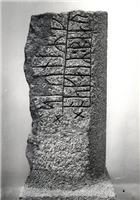Asger
The roots of the masculine name Asger go more than one thousand years back in time and it can thus be considered to be an old Nordic name. The actual form Asger, however, is a modern reconstruction. We shall return to this matter below.
 Once upon a time a viking about the year 1000 wrote his name in runes on a stone near Århus, which now stands in Moesgård Museum – see the picture on the right. The stone has been broken but according to the database Danske Runeindskrifter the surviving part of the text can be read as:
Once upon a time a viking about the year 1000 wrote his name in runes on a stone near Århus, which now stands in Moesgård Museum – see the picture on the right. The stone has been broken but according to the database Danske Runeindskrifter the surviving part of the text can be read as:
: ąskaiR : biar... | : s-a-naR : þ(a)... | ...-----...
(which translates as : Asger Bjørn's ?[son] ... these stones ...)
At the bottom left stands the name of the man who probably erected the stone and, transliterated into Roman characters, the form of the name on the stone is ąskaiʀ. The runic form can by linguistic means be normalized as Old Danish ĀsgæiRR (with long a for older nasalized a, the older æi-diphthong and the nominative ending -R). In the medieval (Old Danish) period this form would have been Āsgēr (with long a, long e for the older æi-diphthong and loss of the nominative ending). It is a masculine name that was originally formed as a compound of two words: the first element is identical with the Old Danish word ās with the meaning '(heathen) god' and the second element is identical with the Old Danish word gēr that means 'spear'.
There can hardly have been any close semantic relationship between the two elements in these kinds of old names, so it is not possible to translate the name Āsgēr as 'god-spear' or the like. The names of Nordic antiquity nevertheless reflect what was thought to be important and prestigious by our ancestors. By far the majority of the compound names contain words for wealth, power, warfare, defence, honour, strength, fame and the like. The first element is often, as in this case, identical with a word that is associated with the pre-Christian pantheon, and most frequent among all the known examples are those with the god's name Tor, e.g. Torbjørn, Torsten, Torkil etc.
From old-fashioned to born-again
Together with many of the old Nordic names the name Asger dropped out of use in the Middle Ages and instead it became modern for Danes to use the names that had been learnt through the new religion and its representatives. A mutated form of the name Āsgēr, namely Æsgēr (with long æ) continued to form part of the nomenclature throughout the medieval period, and it appears in our sources with spellings such as Esger, Esgar, Esgerus (as latinised form), Æsge, Esge and Eske. The last two forms have remained in use ever since and particularly the form with -k- is still used today, although infrequently.
It was first in the second half of the nineteenth century that the form Asger began again to be used as a boy's name. Cultural life in the nineteenth century was dominated by the Romantic movement and in Denmark the ideology of the movement expressed itself in an interest for – and a study of – Scandinavian antiquity and its heroes. The literature of the time was marked by translations of medieval texts and by poetry about Nordic gods and legendary kings. The authors gave their heroes and heroines extinct Nordic names in adapted forms and in this way brought the names back to life again.
The name Asger was in this way created as a modern reconstruction of the old Āsgēr. Other familiar names such as Axel, Harald, Holger, Agnes, Inge and Rigmor are also examples of this type of literary name. The use by the middle classes and later also the rural population of these literary names created a name fashion that name scholars have later come to refer to as the Nordic Renaissance.
From runic inscriptions in the whole of Scandinavia we know of about twenty men with the name ĀsgæiRR or Āsgēr and this number is comparatively large in relation to the total known number of names from the runic period. The reconstructed literary form Asger has never been at the top of the popularity charts but it has had a reasonable dissemination since it first came into use. Throughout the last quarter of a century, however, its popularity has been slowly, but steadily, increasing. The form Eske, on the other hand, does not seem to be moving towards greater popularity. This is probably because its pronunciation is identical with that of the word æske 'box' that has nothing whatever to do with the meaning of the name.
